5 मिनट
The Graph के बारे में
The Graph क्या है?
The Graph एक शक्तिशाली विकेंद्रीकृत प्रोटोकॉल है जो ब्लॉकचेन डेटा को आसानी से क्वेरी और इंडेक्स करने में सक्षम बनाता है। यह ब्लॉकचेन डेटा को क्वेरी करने की जटिल प्रक्रिया को सरल बनाता है, जिससे डैप विकास तेज और आसान हो जाता है।
मूल बातें समझना
जटिल स्मार्ट कॉन्ट्रैक्ट्स वाले प्रोजेक्ट्स, जैसे Uniswap और NFT इनिशिएटिव्स जैसे Bored Ape Yacht Club, डेटा को एथेरियम ब्लॉकचेन पर स्टोर करते हैं, जिससे ब्लॉकचेन से सीधे मूलभूत डेटा के अलावा किसी अन्य जानकारी को पढ़ना बहुत कठिन हो जाता है।
The Graph के बिना चुनौतियाँ
उदाहरण के रूप में, Bored Ape Yacht Club के मामले में, आप the contract पर बुनियादी रीड ऑपरेशन कर सकते हैं। आप किसी विशेष एपी के मालिक को पढ़ सकते हैं, एपी के ID के आधार पर कंटेंट URI पढ़ सकते हैं, या कुल आपूर्ति को पढ़ सकते हैं।
-
यह संभव है क्योंकि ये पढ़ाई संचालन सीधे स्मार्ट कॉन्ट्रैक्ट में प्रोग्राम किए गए हैं। हालांकि, अधिक उन्नत, विशिष्ट और वास्तविक दुनिया की क्वेरीज़ और संचालन जैसे कि एग्रीगेशन, सर्च, रिलेशनशिप, और जटिल फ़िल्टरिंग, संभव नहीं हैं।
-
उदाहरण के लिए, यदि आप किसी विशेष पते द्वारा स्वामित्व वाले Apes के बारे में पूछताछ करना चाहते हैं और किसी विशेष विशेषता के आधार पर अपनी खोज को परिष्कृत करना चाहते हैं, तो आप यह जानकारी सीधे कॉन्ट्रैक्ट के साथ बातचीत करके प्राप्त नहीं कर पाएंगे।
-
ज्यादा डेटा प्राप्त करने के लिए, आपको हर एक
transfer इवेंट को प्रोसेस करना होगा, IPFS से Token ID और IPFS हैश का उपयोग करके मेटाडेटा पढ़ना होगा, और फिर उसे संक्षिप्त करना होगा।
यह एक समस्या क्यों है?
यह सरल सवालों का जवाब पाने में एक ब्राउज़र में चल रही एक विकेन्द्रीकृत एप्लिकेशन (dapp) को घंटे या यहाँ तक कि दिन लग सकते हैं।
Alternatively, you have the option to set up your own server, process the transactions, store them in a database, and create an API endpoint to query the data. However, this option is resource intensive, needs maintenance, presents a single point of failure, and breaks important security properties required for decentralization.
ब्लॉकचेन की विशेषताएँ, जैसे अंतिमता, चेन पुनर्गठन, और अंकल ब्लॉक्स, प्रक्रिया में जटिलता जोड़ती हैं, जिससे ब्लॉकचेन डेटा से सटीक क्वेरी परिणाम प्राप्त करना समय लेने वाला और अवधारणात्मक रूप से चुनौतीपूर्ण हो जाता है।
The Graph एक समाधान प्रदान करता है
The Graph solves this challenge with a decentralized protocol that indexes and enables the efficient and high-performance querying of blockchain data. These APIs (indexed “Subgraphs”) can then be queried with a standard GraphQL API.
आज एक विकेंद्रीकृत प्रोटोकॉल है, जो Graph Node के ओपन सोर्स इम्प्लीमेंटेशन द्वारा समर्थित है, जो इस प्रक्रिया को सक्षम बनाता है।
The Graph कैसे काम करता है
Indexing blockchain data is very difficult, but The Graph makes it easy. The Graph learns how to index Ethereum data by using Subgraphs. Subgraphs are custom APIs built on blockchain data that extract data from a blockchain, processes it, and stores it so that it can be seamlessly queried via GraphQL.
विशिष्टताएँ
-
The Graph uses Subgraph descriptions, which are known as the Subgraph manifest inside the Subgraph.
-
The Subgraph description outlines the smart contracts of interest for a Subgraph, the events within those contracts to focus on, and how to map event data to the data that The Graph will store in its database.
-
When creating a Subgraph, you need to write a Subgraph manifest.
-
After writing the
subgraph manifest, you can use the Graph CLI to store the definition in IPFS and instruct an Indexer to start indexing data for that Subgraph.
The diagram below provides more detailed information about the flow of data after a Subgraph manifest has been deployed with Ethereum transactions.

प्रवाह इन चरणों का पालन करता है:
- एक विकेंद्रीकृत एप्लिकेशन स्मार्ट अनुबंध पर लेनदेन के माध्यम से एथेरियम में डेटा जोड़ता है।
- लेन-देन संसाधित करते समय स्मार्ट अनुबंध एक या अधिक घटनाओं का उत्सर्जन करता है।
- Graph Node continually scans Ethereum for new blocks and the data for your Subgraph they may contain.
- Graph Node finds Ethereum events for your Subgraph in these blocks and runs the mapping handlers you provided. The mapping is a WASM module that creates or updates the data entities that Graph Node stores in response to Ethereum events.
- नोड के GraphQL समापन बिंदु का उपयोग करते हुए, विकेन्द्रीकृत एप्लिकेशन ब्लॉकचैन से अनुक्रमित डेटा के लिए ग्राफ़ नोड से पूछताछ करता है। ग्राफ़ नोड बदले में इस डेटा को प्राप्त करने के लिए, स्टोर की इंडेक्सिंग क्षमताओं का उपयोग करते हुए, अपने अंतर्निहित डेटा स्टोर के लिए ग्राफ़कॉल प्रश्नों का अनुवाद करता है। विकेंद्रीकृत एप्लिकेशन इस डेटा को एंड-यूजर्स के लिए एक समृद्ध यूआई में प्रदर्शित करता है, जिसका उपयोग वे एथेरियम पर नए लेनदेन जारी करने के लिए करते हैं। चक्र दोहराता है।
अगले कदम
The following sections provide a more in-depth look at Subgraphs, their deployment and data querying.
Before you write your own Subgraph, it’s recommended to explore Graph Explorer and review some of the already deployed Subgraphs. Each Subgraph’s page includes a GraphQL playground, allowing you to query its data.